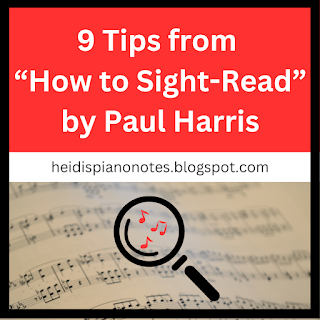Sight-reading has never been something I feel is my musical superpower so I am always eager to find more tips on developing this skill.
Today I was so excited to watch a piano webinar hosted by the Curious Piano Teachers featuring Paul Harris to learn some new ideas regarding this topic. I also hoped to pick up some practical tips to help my piano students sight-read with fluency and confidence too.
9 Tips About How To Sight-Read by Paul Harris
I love the 9 tips that he shared that he delves into more deeply in his new book "How to Sight Read" and look forward to reading it. I asked permission to share the 9 basic tips (from my webinar notes).
I decided to note some specific action items that his list sparked in my mind about how to help my piano students sight-read with fluency and confidence. It's easy to feel inspired at a workshop, but unless I take action quickly, that boost of energy becomes lost in my piano notebook pretty quickly😉.
I hope I can put these tips into practice right away. The bold headings below are the topics Paul expounds on in his book.
1- Know the Musical Ingredients
Before starting a new piece play a quick game of "I Spy" as students locate terms and signs in their music as fast as they can. Saying the following prompts can refresh their memory, help you determine which musical ingredients they are aware of and make patterns and expressive markings more salient so they are more likely to play them accurately.
I spy a symbol that means hold the note longer. (fermata)
I spy the shortest type of articulation (staccatissimo)
I spy 4 different dynamic markings. Can you color them in 10 seconds?
2- Hear it in Your Head (Audiation)
3-Increase Brain Processing Speed and Patterns
4-Increase Peripheral Vision
Try the Peripheral Vision Exercises in Paul Harris's new Sight Reading App and add them into my Piano Lab Assignments.
Experiment using a moving paper to cover the music of sightreading measures for students before they play it forcing them to look ahead in the music.


No comments:
Post a Comment